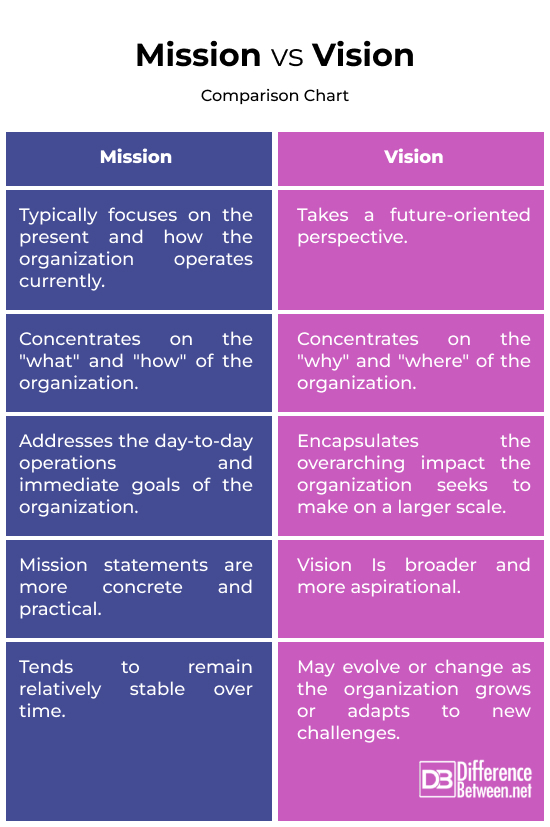Difference Between Mission and Vision
Do you know what the world’s brilliant minds or leaders have in common? They all have a vision and go on a mission to achieve their goals and objectives. A mission or vision is meant to be more than just slogans that make organizations look good. Together, they act like a compass, keeping everyone on the same path toward success. The mission tells us why the company does what it does, and the vision paints a picture of where it’s headed. Let’s delve deeper and try to understand the differences between the mission and vision of an organization.

What is a mission?
A mission statement is like a company’s mission in a nutshell. It’s a brief, clear declaration that explains why the organization exists and what it aims to accomplish. It serves as a guiding light, helping everyone in the company understand the purpose and focus on common goals. Your mission helps you create a comprehensive plan and outline the strategic steps necessary to attain predefined goals.
It serves as a metric for gauging progress and discerning the efficacy of current strategies, guiding the organization to recalibrate if needed. It articulates the strategic means by which an organization intends to achieve its overarching purpose and ultimate objectives.

What is a vision?
A vision is a forward-looking, inspirational statement that encapsulates the long-term aspirations and desired future state of an organization. It serves as a guiding beacon, providing a clear and vivid picture of what you aim to achieve over an extended period. It’s like a roadmap that guides you and your team towards a compelling and desired future state. It serves as a constant reminder of the bigger picture and fuels enthusiasm to keep you motivated and focused as you work to turn that vision into reality.
Together, the mission and vision of an organization focus people’s attention on a common dream or outcome. It defines a shared goal to guide behavior. They begin to define, articulate, and communicate the purpose and values of an organization to others, including employees, owners, executives, consumers, and so on.
Difference between Mission and Vision
Timeframe
A mission addresses the present and provides a snapshot of the organization’s current purpose and operations. It outlines the “what” and “how” of its existence. Vision, on the other hand, takes a future-oriented perspective and looks into a company’s overarching vision, detailing the desired state the organization aspires to achieve over the long term. It answers the questions of “why” and “where” the organization is heading.
Focus
A mission outlines the fundamental purpose and immediate objectives of an organization. It directs attention to the immediate goals and day-to-day operations, emphasizing the practical aspects of the organization’s existence. Vision shifts the focus to the bigger picture; it encapsulates the grander aspirations and overarching impact the organization seeks to make on a larger scale.
Scope
Mission has a narrower scope and deals with the specifics of the organization’s current activities, values, and operations. Vision, on the contrary, has a broader scope and encompasses the larger societal or global contribution the organization aims to make, transcending day-to-day operations.
Examples
Tesla’s mission statement is “to accelerate the world’s transition to sustainable energy.” The company’s vision is to create the most compelling car company of the 21st century by driving the world’s transition to electric vehicles. Google’s mission statement is “to organize the world’s information and make it universally accessible and useful.” Its vision is to provide access to the world’s information in one click.
Mission vs. Vision: Comparison Chart

Summary
In general, a company’s mission statement succinctly defines its current purpose, outlining the fundamental “what” and “how” of its operations. On the other hand, the vision statement looks to the future, encapsulating the aspirational “why” and “where” the organization aims to be in the long term. Mission statements often focus on immediate goals and daily operations, while vision emphasizes the larger societal impact or contribution the company envisions.
FAQs
Which comes first, vision or mission?
Before selecting a destination or envisioning the future (vision), it’s crucial to define the purpose (mission) of the business. So, the mission comes first and the vision statement then follows.
What are vision and mission examples?
Tesla’s mission statement is “to accelerate the world’s transition to sustainable energy.” The company’s vision is to create the most compelling car company of the 21st century by driving the world’s transition to electric vehicles.
How is purpose different from mission and vision?
Purpose answers the fundamental question of why your organization exists and its underlying reason for being. It often taps into values and emotions. The mission and vision then articulate how and what you do to fulfill that purpose.
What are the three parts of a mission statement?
A mission statement typically includes:
- Purpose: The reason for existence.
- Values: The guiding principles.
- Goals: The specific objectives.
What are three differences between mission and vision?
- Mission focuses on the present and near future, while vision looks further into the future, often painting an ideal picture.
- Mission outlines concrete actions and activities, while vision is more aspirational and descriptive.
- Mission is more specific, describing who you serve and what you do, while vision is broader and more conceptual.
What are three examples of a vision statement?
- “To be a globally recognized leader in sustainable innovation.”
- “To create a world where every person has access to quality education.”
- “To be the preferred employer, fostering a diverse and inclusive workplace culture.”
- Difference Between Caucus and Primary - June 18, 2024
- Difference Between PPO and POS - May 30, 2024
- Difference Between RFID and NFC - May 28, 2024
Search DifferenceBetween.net :
4 Comments
Trackbacks
Leave a Response
References :
[0]“Vision vs. Mission Statement: What’s the Difference?” MasterClass, 14 Dec. 2021, www.masterclass.com/articles/vision-vs-mission.
[1]Cox, Lindsay Kolowich. “32 Mission and Vision Statement Examples That Will Inspire Your Buyers.” HubSpot, 11 May 2023, blog.hubspot.com/marketing/inspiring-company-mission-statements#missionvsvision.
[2]Wooll, Maggie. “Purpose, mission, vision: What drives what?” BetterUp, 30 July 2022, www.betterup.com/blog/purpose-vs-mission-vision.
[3]Pereira, Daniel. “Tesla Mission and Vision Statement.” The Business Model Analyst, 22 May 2023, https://businessmodelanalyst.com/tesla-mission-and-vision-statement/.
[4]Image credit: https://www.canva.com/photos/MAEHqms1aPw-vision-mission-puzzle/
[5]Image credit: https://www.canva.com/photos/MAFeHtSBQ1c-vision-mission-concept-on-the-gearwheels-3d-rendering/

to be very realistic if my vision is to be intelligent, would my mission be studying critically, regularly?
Arif, you asked a good question. Vision is long-term inspiration and for this you should set your mission like in your example be punctual in critical study.
My purpose for the research was achieved,God richly bless you.